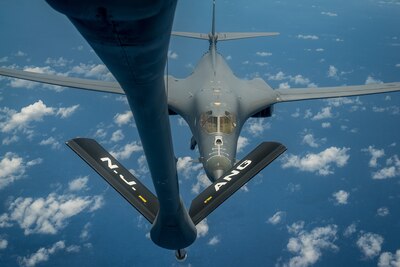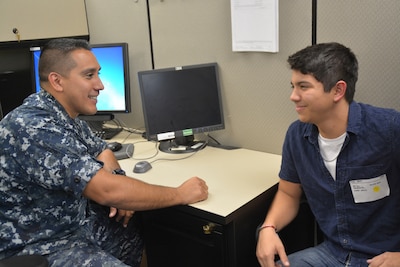By Cheryl Pellerin DoD News, Defense Media Activity
WASHINGTON, Sept. 15, 2017 — On behalf of Defense Secretary
Jim Mattis, Deputy Defense Secretary Pat Shanahan honored former prisoners of
war and remembered 83,000 Americans still unaccounted for since World War II.
Shanahan hosted the Defense Department’s National POW/MIA
Recognition Day ceremony today at the Pentagon River Terrace Parade Field.
Speeches were followed by a pass in review, a joint service anthem medley and a
flyover of two FA-18 Hornets.
Joining Shanahan in addressing U.S. ambassadors from several
countries, veteran’s advocates, military veterans, families of those missing in
action and former prisoners of war, was Army Command Sgt. Maj. John Wayne
Troxell, senior enlisted advisor to the chairman of the Joint Chiefs of Staff.
Sacred Mission
“Since our founding it has been our military's sacred pledge
to never leave anyone behind,” Troxell said. “We will account for, bury with
honor, respect and, if possible, bring home to our shores every one of those
selfless warriors who lies within our earthly power to reach.”
Today, he added, everyone in the audience renews the pledge
to bring closure to the families of service members missing in action.
“From the jungles of South Asia to the fields of France and
beyond, men and women of the Department of Defense have dedicated their lives
to tracking down every lead, leaving no stone unturned, to return or loved ones
home where they belong,” Troxell said.
Fallen Troops
“The example we set today will guide future generations and
continuing this sacred mission,” he added.
Two Colors, a Silhouette
More often than not, Shanahan said during his remarks, as
the American flag waves the POW/MIA flag flies beneath it, instantly
recognizable to millions of Americans.
“We thank the [National League of American Prisoners and
Missing in Southeast Asia] for that. With two colors and a silhouette, you
galvanized a generation to compassionate action for this community,” Shanahan
said.
Over the past year the Defense Department’s POW/MIA
Accounting Agency has conducted 34 investigative missions and 40 recovery
missions, and repatriated Americans lost in World War II, the Korean War and
the Vietnam War, he added.
Since last year's POW/MIA Recognition Day, Shanahan said,
the agency has accounted for 155 fallen service members.
Full Military Honors
“By their work, the agency's devoted men and women,
strategic partners and host nations secured recognition and full military
honors for heroes like Alberic M. Blanchette,” the deputy secretary said.
Marine Corps Reserve Pvt. Blanchette, 19, from Caribou,
Maine, assigned to Company K, 3rd Battalion, 2nd Marines, 2nd Marine Division,
died on the first day of fierce combat on Tarawa Atoll in the Central Pacific
in 1943. He returned home this month, 75 years later, Shanahan said.
The agency also recently repatriated the remains of Air
Force Capt. Robert E. Holton, 27, of Butte, Montana, an A-4 Skyhawk pilot with
the 497th Tactical Fighter Squadron in the Vietnam War. He was lost on an armed
reconnaissance mission over southern Laos in 1969.
Between 1994 and 2011, the Defense Department conducted nine
investigations and excavated sites in Vietnam and Laos to try to bring Bolton
home. In January a joint U.S.-Laotian team recovered his remains.
“Why did we go to such lengths?” Shanahan asked. “Because we
refused to forget Robert Holton.”
And last month the agency announced identifying the remains
of Max E. Harris, 21, of Monticello, Indiana, an Army sergeant who deployed
with the 3rd Battalion, 31st Infantry Regiment to an area east of the Chosin
Reservoir in Korea in 1950.
“After a fierce battle Max was captured by Chinese forces,”
Shanahan said. “A year later en route to a prisoner of war camp, he died. We
refused to forget Max Harris. Decades later, painstaking research and
scientific analysis enabled the agency to identify Max.”
Poster for National POW/MIA Recognition Day 2017. DoD
graphic
Thanks to such testing, he added, “we can now ensure no
service member ever returns home unknown. The work is far from complete but it
will go on with fervor.”
Shanahan said that under the leadership of director Kelly K.
McKeague, who Mattis appointed just last week, “the agency will strive daily to
fulfill this solemn responsibility.”
Shanahan thanked the families of the missing for sharing
their quiet courage and steadfastly waiting for answers. He thanked veterans’
organizations for their ceaseless efforts on veterans’ behalf.
To the devoted professionals of the Defense POW/MIA
Accounting Agency, he added, “thank you for persevering to fulfill our nation's
promise. And to all former POWs who endured, who withstood the fear, anguish
and pain, thank you for your powerful inspiration to us today.”










